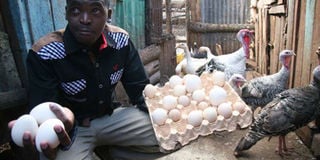What I’ve learnt on keeping turkeys

Martin Njau, a farmer from Ikinu feeding his turkeys on June 4, 2014. PHOTO | JENNIFER MUIRURI
What you need to know:
- And therefore, one big mistake I did with the birds, like many other farmers, was that I kept them under free-range system together with chickens.
- I opted for a broody hen and it worked, although I had to wait for 28 days, not the typical 21. Broody hens don’t come off the nest after laying, they continue to sit there all day and night, coming off only for food and water.
Many people interested in rearing poultry only think about chicken and forget a whole range of other exciting birds like turkeys, geese, ducks and guinea fowls.
Besides chickens, I also rear ornamental birds, which I started keeping in March 2013 after a good number of my kienyeji chicks raised under traditional indigenous conditions died. I needed to diversify my investments to spread the risks.
After fencing off my two-acre farm in Busia and planting grass and trees to provide adequate space and shades, I knew I was ready to go. I resisted stories bandied about the difficulties in keeping turkeys and went ahead to keep them. However, unlike with my chicken project, I did not seek any expert advice when I started.
And therefore, one big mistake I did with the birds, like many other farmers, was that I kept them under free-range system together with chickens.
Turkeys are indigenous to America and are an essential part of Christmas and other celebrations. Some breeders even keep turkeys for exhibition.
I started off with five adult birds, two males and three females. I won’t bore you with names of different breeds for now, but having the bronze and pure white varieties roaming your compound aimlessly is a breathtaking and relaxing experience, particularly if you have children running around the compound the whole day.
They say if you don’t want to work another day in your life, get a job you love to do that also brings in a good income.
But I must warn you, egg production for turkeys is seasonal; it cannot be compared to chicken. Forget about the 200-300 eggs per year from hens. Light weight turkey breeds are expected to lay between 85 and 100 eggs, medium breeding from 50 to 70 while heavier breeds about 50 eggs.
I was lucky to get 20 eggs after waiting for one year, although the seller had informed me that the turkey hen had started laying eggs when I bought it.
I needed to hatch the eggs into poults (baby turkeys) to increase my flock.
But there was another problem. Hen turkeys are generally not good mothers and unless you have one you know to be reliable, don’t attempt to use them for brooding.
URGE TO BROOD
I opted for a broody hen and it worked, although I had to wait for 28 days, not the typical 21. Broody hens don’t come off the nest after laying, they continue to sit there all day and night, coming off only for food and water.
Instead of separating hens showing such signs from the rest of the flock, and placing them in a small cage on slats with food and water for five days to kill the urge to ‘brood,’ you can safely use these to hatch turkey poults.
I was delighted when I removed 12 turkey poults from the mother hen to put into the specially made brooder house that also contained some chicks. Turkey poults, compared to chicks in size, look like tiny giants.
I installed a light bulb in the brooder house to provide heating. For the first one week temperature should be between 32 and 38 degrees. Thereafter, one is advised to reduce floor temperature by two degrees each week for the next four weeks.
I also provided feed and water containers. Feed for turkey poults must contain at least 24 per cent protein (not found in many commercial feeds), 2 per cent calcium and 0.9 per cent phosphorus. For the first three days, I was giving them milk and hard boiled eggs using a spoon.
From day two, the poults should be given insoluble grit either in form of granite or flint grit to improve feed conversion efficiency. Providing grit this early helps them develop a large gizzard to digest roughage later. Turkeys with large gizzards have higher cold-dressed weights.
The birds did well until the eighth week when I released them to free-range with my chickens.
But that was the fatal mistake I did. You see, it is inadvisable to allow young turkeys to free-range where hens have ventured recently because of a disease called blackhead (histoplasmosis).
Chicken are normally carriers of the parasite causing the disease that is released through their droopings, which if eaten by turkeys, they get infected.
To prevent this disease, one can include anti-blackhead medication like dimetridazole that in normally mixed in the poults’ feed.
If symptoms are recognised early, sick birds should be started on a course of a herbal drug called Herban, which cures even badly affected birds. I didn’t know all this at that time.
Out of the five adult turkeys, one was killed by predators. Two also died from what I suspect was blackhead disease. Now being wiser, I am planning to transfer the remaining two to my farm in Njiru to start again as I want to turn the venture commercial. Turkeys go for as much as Sh5,000 each, which is not a bad sum.





